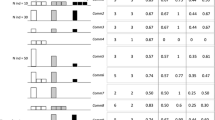Abstract
Most diversity indices widely used in ecology (e.g. the Shannon-Wiener index and the Gini-Simpson index) do not reflect taxonomic or other differences among species. Quadratic entropy, proposed by C.R. Rao (1982), takes these differences into account. The aim of this paper is to demonstrate the application of this diversity index in investigations of drosophilid species diversity. Quadratic entropy and Simpson index values are also compared. The elements of the difference matrix in the quadratic form are taxonomic differences (distances) among the species. The difference is defined by the position of the lowest-ranking taxon containing both species. According to the results, the Gini-Simpson index and the taxonomic quadratic entropy are positively correlated. The observed differences are due to the fact that assemblages with greater taxonomic distances produce greater quadratic entropy. Drosophilid species can be assigned to specific life habit classes, more specifically to resource types. After postulating differences between the types, we used the quadratic entropy measure to analyse resource diversity. These kinds of examinations approximate to an operative association of species diversity and environmental diversity.
Similar content being viewed by others
Additional references
Grassle, J.F., Patil, G.P., Smith, W.K. and Taillie, C. (eds). (1979) Statistical Ecology Volume 6: Ecological Diversity in Theory and Practice. International Co-operative Publishing House, Fairland, MD.
Magurran, A.E. (1988) Ecological Diversity and Its Measurement. Princeton University Press, Princeton, NJ.
Patil, G.P. and Taillie, C. (1982) Diversity as a concept and its measurement. Journal of the American Statistical Association, 77, 548–67.
Patil, G.P. and Rosenzweig, M.L. (1979) Statistical Ecology Volume 12: Contemporary Quantitative Ecology and Related Ecometrics. International Co-operative Publishing House, Fairland, MD.
Rao, C. R. (1984) Diversity: its measurement, decomposition, apportionment and analysis. Sankhya, Set. A, 44, 1–22.
Smith, W. (1989) ANOVA like similarity analysis using expected species shared. Biometrics, 45, 873–81.
Smith, W. and Grassle, J.F. (1977) A diversity index and its sampling properties. Biometrics, 33, 283–92.
Solow, A.R. (1994) On the Bayesian estimation of the number of species in a community. Ecology, 75, 2139–42.
Solow, A.R. and Polasky, S. (1994) Measuring biological diversity. Environmental and Ecological Statistics, 1, 95–107.
Author information
Authors and Affiliations
Rights and permissions
About this article
Cite this article
Izsáki, J., Papp, L. Application of the quadratic entropy indices for diversity studies of drosophilid assemblages. Environ Ecol Stat 2, 213–224 (1995). https://doi.org/10.1007/BF00456668
Received:
Revised:
Issue Date:
DOI: https://doi.org/10.1007/BF00456668




